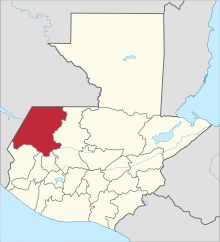Akatek language
| Akatek | |
|---|---|
| Acateco | |
| Kuti, q'anub'al' | |
| Native to | Guatemala Mexico |
| Region | Huehuetenango Chiapas |
| Ethnicity | 66,000 Akateko in Guatemala (2019 census) |
Native speakers | 65,000 in Guatemala (2011 – 2019 census)[2] 2,900 in Mexico (2020 census)[1] |
Mayan
| |
| Latin | |
| Official status | |
Recognised minority language in | |
| Regulated by | Instituto Nacional de Lenguas Indígenas Academia de Lenguas Mayas de Guatemala |
| Language codes | |
| ISO 639-3 | knj |
| Glottolog | west2635 |
| ELP | Akateko |
Akatek is a Mayan language spoken by the Akateko people primarily in the Huehuetenango Department, Guatemala in and around the municipalities of Concepción Huista, Nentón, San Miguel Acatán, San Rafael La Independencia and San Sebastián Coatán.[3] A number of speakers also live in Chiapas, Mexico. It is a living language with 58,600 speakers in 1998, of which 48,500 live in Guatemala and the remaining in Mexico.[4] Alternate spellings for the language include Akatec, Akateko, and Akateco.

Akateko stems from the Q'anjob'alan branch, making it closely related to Q’anjob’al and Chuj.[5]
History
[edit]Akateko was regarded as a dialect of the Qʼanjobʼal language until the 1970s, when linguists realized that it has a distinct grammar from that of Qʼanjobʼal.[6] That it has been thought a dialect of Qʼanjobʼal is reflected in the many names Akateko has had through time. One of its primary names before it was named Akateko was Ti Western Qʼanjobʼal, but it has also been called Conob and various names including Qʼanjobʼal and the municipality where it is spoken.
Akateko is closely related to the two Mayan languages, Qʼanjobʼal and Jakaltek. The three languages together form the Qʼanjobʼal-Jakaltek sub-branch, which together with the Mochoʼ language form the Qʼanjobʼalan sub-branch, which again, together with the Chujean languages, Chuj and Tojolabʼal, form the branch Qʼanjobalan–Chujean. It is believed that Qʼanjobʼal–Jakaltek split into Akateko, Qʼanjobʼal and Jakaltek some 500 to 1,500 years ago.[citation needed]
Classifiers in Akatek
[edit]Akateko, Q’anjob’al and Chuj all utilize similar classifiers to organize nouns. Nouns are divided into three categories: humans, animals and inanimate objects and there is no generic classifier. [5][7]
Akatek has 14 nominal classifiers. [7]
Grammar
[edit]An interesting aspect of Akateko grammar, which is also present in most other Qʼanjobalan languages, is the use of directional morphemes, which appear as enclitics. These morphemes make it possible for the speaker to talk about movement and direction in space without pointing or using other gestures. Consider the stative verb [ʔej] to be, which can appear as [ʔejʔok] existing inwards, [ʔejtok] existing towards there, away from the speaker and listener and [ʔeːltox] existing from the inside out, using different enclitics.
Standard verb roots are classified in multiple categories at once.[8]
Phonology
[edit]Vowels
[edit]Akatek has 5 vowels:
| Front | Back | |
|---|---|---|
| Unrounded | Rounded | |
| Close | i | u |
| Close-mid | e | o |
| Open | a | |
Vowel length is distinctive, so one can say that the total number of vowels is 10. These long vowels are a unique and recent sound change from Q'anjob'al.[9]
Consonants
[edit]Akatek has 24 consonants, including the glottal stop:
| Bilabial | Alveolar | Postalveolar | Retroflex | Palatal | Velar | Uvular | Glottal | ||
|---|---|---|---|---|---|---|---|---|---|
| Nasal | m ⟨m⟩ | n ⟨n⟩ | |||||||
| Plosive | Plain | p ⟨p⟩ | t ⟨t⟩ | k ⟨k⟩ | q ⟨q⟩ | ʔ ⟨’⟩ | |||
| Ejective | tʼ ⟨tʼ⟩ | kʼ ⟨kʼ⟩ | qʼ ⟨qʼ⟩ | ||||||
| Implosive | ɓ ⟨bʼ⟩ | ||||||||
| Affricate | Plain | t͡s ⟨tz⟩ | t͡ʃ ⟨ch⟩ | ʈ͡ʂ ⟨tx⟩ | |||||
| Ejective | t͡sʼ ⟨tzʼ⟩ | t͡ʃʼ ⟨chʼ⟩ | ʈ͡ʂʼ ⟨txʼ⟩ | ||||||
| Fricative | s ⟨s⟩ | ʃ ⟨xh⟩ | ʂ ⟨x⟩ | x ⟨j⟩ | |||||
| Tap | ɾ ⟨r⟩ | ||||||||
| Approximant | w ⟨w⟩ | l ⟨l⟩ | j ⟨y⟩ | ||||||
/p/ is realized as [pʰ] word-finally, [p] everywhere else.
- Examples: pom [pom] copal, xopan [ʃopan] hollow, sip [sipʰ] tick
/k/ is realized as [kʰ] word-finally, [k] everywhere else.
- Examples: kaapʼ [kaːɓ̥] two, mooke [moːke] tinaja, chʼok [t͡ʃʼokʰ] zanate
/t/ is realized as [tʰ] before plosive consonants, [t] everywhere else.
- Examples: teʼ [teʔ] tree, satkan [satʰkan] sky, pʼit [ɓit] song
/ɓ/ is realized as [ɓ̥] word-finally, [ɓ] everywhere else.
- Examples: kaapʼ [kaːɓ̥] two, pʼeyʼpʼal [ɓejɓal] the walking (thing)
/x/ is realized as [h] word-initially, [x] everywhere else.
- Examples: xos [hos] egg, ajane [ʔaxane] foot
/n/ is realized as [m] before /p/ and /ɓ/, but [ŋ] before alveolar and velar consonants, [n] everywhere else.
- Examples: Examples: inpʼit [imɓit] my song, ante [ʔaŋte] to cure, naa [naː] house
References
[edit]- ^ Lenguas indígenas y hablantes de 3 años y más, 2020 INEGI. Censo de Población y Vivienda 2020.
- ^ Akatek at Ethnologue (24th ed., 2021)

- ^ Cabral, Ernesto Díaz Couder (2001). "Culturas e interculturalidad en Guatemala". Archived from the original on 2010-02-15.
{{cite journal}}: Cite journal requires|journal=(help) - ^ Ethnologue
- ^ a b Law, Danny (2020). Pattern borrowing, linguistic similarity, and new categories: Numeral classifiers in Mayan. Spring Nature. pp. 351–354.
- ^ Maldonado, Roberto Zavala (1992). Acateco de la frontera sur.
- ^ a b Zavala, Roberto (2000). Systems of Nominal Classifiers: Multiple classifier systems in Akatek (Mayan) (Gunter Seft ed.). Cambridge University Press. p. 118.
- ^ Henderson, Robert (2016). "Mayan Semantics". Language and Linguistics Compass. 10 (10): 551–588. doi:10.1111/lnc3.12187.
- ^ Bennett, Ryan (2016). "Mayan phonology". Language and Linguistics Compass. 10 (10): 469–514. doi:10.1111/lnc3.12148.
